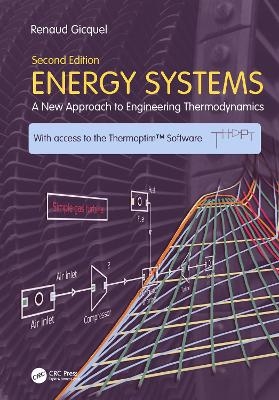
Energy Systems
CRC Press (Verlag)
978-0-367-72600-3 (ISBN)
Considered as particularly difficult by generations of students and engineers, thermodynamics applied to energy systems can now be taught with an original instruction method. Energy Systems applies a completely different approach to the calculation, application and theory of multiple energy conversion technologies. It aims to create the reader’s foundation for understanding and applying the design principles to all kinds of energy cycles, including renewable energy. Proven to be simpler and more reflective than existing methods, it deals with energy system modeling, instead of the thermodynamic foundations, as the primary objective. Although its style is drastically different from other textbooks, no concession is made to coverage: with encouraging pace, the complete range from basic thermodynamics to the most advanced energy systems is addressed.
The accompanying Thermoptim™ portal (http://thermoptim.org) presents the software and manuals (in English and French) to solve over 200 examples, and programming and design tools for exercises of all levels of complexity. The portal explains to the user how to build appropriate models to bridge the technological reality with the theoretical basis of energy engineering. Offering quick overviews through e-learning modules moreover, the portal is user-friendly and enables users to quickly improve their proficiency. Students can freely download the Thermoptim modeling software demo version (available in seven languages), and extended options are available to lecturers. A professional edition is also available and has been adopted by many companies and research institutes worldwide (www.s4e2.com).
This volume is intended as a textbook for courses in applied thermodynamics, energy systems, energy conversion and thermal engineering taken by senior undergraduate and graduate-level students in mechanical, energy, chemical and petroleum engineering. Students should already have taken a first-year course in thermodynamics. The refreshing approach and exceptionally rich coverage make it a great reference tool for researchers and professionals as well.
Active as a full professor from 1986 to 2020, Dr. Renaud Gicquel has taught a wide variety of subjects, such as applied thermodynamics and global energy issues and energy system modeling. His recent research activities were focused on the optimization of complex thermodynamic plants (heat exchanger networks, cogeneration, combined cycles) and on the use of information and communication technologies for scientific instruction. Renaud’s special interest and passion is the combination of thermodynamics and energy-powered system education with modern information technology tools. To this end, he has developed various software packages to facilitate the teaching and learning of applied thermodynamics and the simulation of energy systems: Thermoptim (Thermo-Calc) professional software, 2000, CSTB, www.cstb.fr Interactive Thermodynamic Charts, 2000 Diapason e-learning modules, 2004, www.thermoptim.org Renaud Giquel is now retired. He was previously Professor at the École des Mines de Paris (Mines ParisTech). He was trained as a mining engineering at the École des Mines and got his doctorate in engineering from the Paris VI University. He started his career as a Special Assistant to the Secretary General of the United Nations Conference on New and Renewable Sources of Energy from in 1980 in New York. He then became the Deputy Director in charge of Dwellings at the Energy Division of the Marcoussis Laboratories of the Compagnie Générale d’Electricité until January 1982, and the Head of multilateral issues in the International Affairs Service of the Ministry for Research and Technology in Paris in 1982. From 1983 to 1985, he was Adviser for International Issues of the National Center of Scientific Research (CNRS). In 1986, he founded with the late Michel Grenon Mediterranean Energy Observatory (OME), based in Sophia Antipolis. In 1990, Dr Gicquel created the ARTEMIS group, a research body for thermal energy research, together with the University of Nantes and ISITEM (now Polytech) in Nantes. He acted as a coordinator and while fulfilling the position of Deputy Director at the Ecole des Mines de Nantes (EMN) from three years form 1991 as well. In 1987 he was named head of the Centre of Energy Studies of the École des Mines de Paris in 1987.
General Introduction. Part 1: A new educational paradigm, Components, functions and reference processes, Modeling of simple cycles in thermodynamics charts and thermoptim. Part 2: Combustion and heat exchangers, Steam systems components, Second law, entropy, exergy, Optimization by thermal integration (pinch method). Part 3: Variants of steam power plants, Conventional internal combustion engines, Combined cycle, cogeneration or CHP, Compression refigeration cycles, Thermodynamics of moist mixtures and air conditioning, Liquid adsorption refigeration cycles, Liquid adsorption refigeration cycles. Part 4: Advanced gas turbines cycles, Stirling, future nuclear reactor and oxyfuel cycles, New and renewable thermal energy cycles, Evaporation, mechanical vapor compression, desalination, drying by hot gas, Electrochemical converters: Fuel cells and electrolysers, General conclusion.
| Erscheinungsdatum | 10.08.2021 |
|---|---|
| Zusatzinfo | 48 Tables, black and white; 525 Line drawings, black and white; 525 Illustrations, black and white |
| Verlagsort | London |
| Sprache | englisch |
| Maße | 210 x 297 mm |
| Gewicht | 1200 g |
| Themenwelt | Technik ► Elektrotechnik / Energietechnik |
| Technik ► Maschinenbau | |
| ISBN-10 | 0-367-72600-9 / 0367726009 |
| ISBN-13 | 978-0-367-72600-3 / 9780367726003 |
| Zustand | Neuware |
| Informationen gemäß Produktsicherheitsverordnung (GPSR) | |
| Haben Sie eine Frage zum Produkt? |
aus dem Bereich


